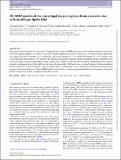Files in this item
3D MHD models of the centrifugal magnetosphere from a massive star with an oblique dipole field
Item metadata
| dc.contributor.author | ud-Doula, Asif | |
| dc.contributor.author | Owocki, Stanley P | |
| dc.contributor.author | Russell, Christopher | |
| dc.contributor.author | Gagné, Marc | |
| dc.contributor.author | Daley-Yates, Simon | |
| dc.date.accessioned | 2023-02-02T10:30:14Z | |
| dc.date.available | 2023-02-02T10:30:14Z | |
| dc.date.issued | 2023-04-01 | |
| dc.identifier | 283208078 | |
| dc.identifier | 529d4f4f-1065-46f0-a997-f128258fd9c8 | |
| dc.identifier | 85150327310 | |
| dc.identifier.citation | ud-Doula , A , Owocki , S P , Russell , C , Gagné , M & Daley-Yates , S 2023 , ' 3D MHD models of the centrifugal magnetosphere from a massive star with an oblique dipole field ' , Monthly Notices of the Royal Astronomical Society , vol. 520 , no. 3 , pp. 3947–3954 . https://doi.org/10.1093/mnras/stad345 | en |
| dc.identifier.issn | 0035-8711 | |
| dc.identifier.other | Bibtex: 10.1093/mnras/stad345 | |
| dc.identifier.uri | https://hdl.handle.net/10023/26884 | |
| dc.description | Funding: This work is supported in part by the National Aeronautics and Space Administration under Grant No. 80NSSC22K0628 issued through the Astrophysics Theory Program. AuD and MRG acknowledge support by the National Aeronautics and Space Administration through Chandra Award Numbers TM-22001 and GO223003X, issued by the Chandra X-ray Center, which is operated by the Smithsonian Astrophysical Observatory for and on behalf of the National Aeronautics Space Administration under contract NAS8-03060. This work used the Bridges2 cluster at the Pittsburgh Supercomputer Center through allocation AST200002 from the Extreme Science and Engineering Discovery Environment (XSEDE), which was supported by National Science Foundation grant number 1548562. | en |
| dc.description.abstract | We present results from new self-consistent 3D MHD simulations of the magnetospheres from massive stars with a dipole magnetic axis that has a non-zero obliquity angle (β) to the star’s rotation axis. As an initial direct application, we compare the global structure of co-rotating disks for nearly aligned (β = 5o) versus half-oblique (β = 45o) models, both with moderately rapid rotation (∼ 0.5 critical). We find that accumulation surfaces broadly resemble the forms predicted by the analytic Rigidly Rotating Magnetosphere (RRM) model, but the mass buildup to near the critical level for centrifugal breakout against magnetic confinement distorts the field from the imposed initial dipole. This leads to an associated warping of the accumulation surface toward the rotational equator, with the highest density concentrated in wings centered on the intersection between the magnetic and rotational equators. These MHD models can be used to synthesize rotational modulation of photometric absorption and H α emission for a direct comparison with observations. | |
| dc.format.extent | 8 | |
| dc.format.extent | 1964798 | |
| dc.language.iso | eng | |
| dc.relation.ispartof | Monthly Notices of the Royal Astronomical Society | en |
| dc.subject | (Magnetohydrodynamics) MHD | en |
| dc.subject | Stars: winds | en |
| dc.subject | Outflows | en |
| dc.subject | Stars: magnetic fields | en |
| dc.subject | Stars: massive | en |
| dc.subject | Stars: mass-loss | en |
| dc.subject | QB Astronomy | en |
| dc.subject | QC Physics | en |
| dc.subject | NDAS | en |
| dc.subject | MCC | en |
| dc.subject.lcc | QB | en |
| dc.subject.lcc | QC | en |
| dc.title | 3D MHD models of the centrifugal magnetosphere from a massive star with an oblique dipole field | en |
| dc.type | Journal article | en |
| dc.contributor.institution | University of St Andrews. School of Physics and Astronomy | en |
| dc.identifier.doi | https://doi.org/10.1093/mnras/stad345 | |
| dc.description.status | Peer reviewed | en |
This item appears in the following Collection(s)
Items in the St Andrews Research Repository are protected by copyright, with all rights reserved, unless otherwise indicated.

